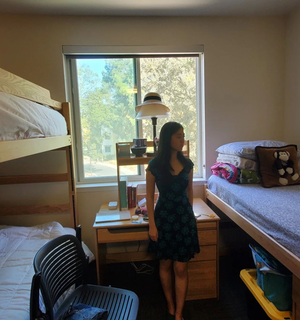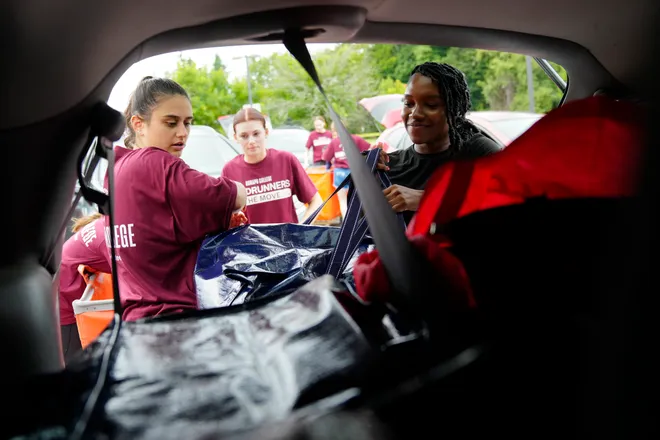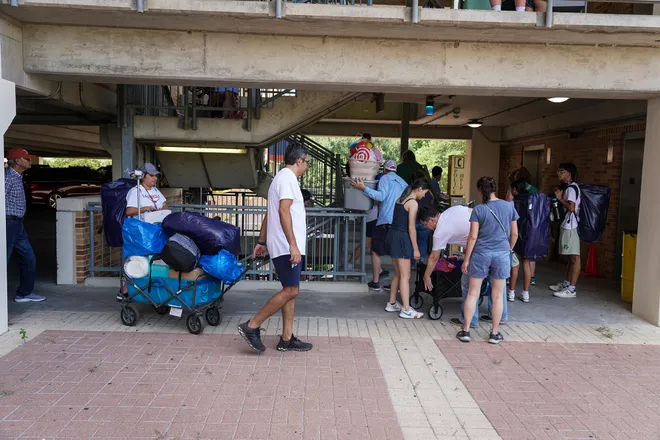Two roommates. A communal bathroom. Why are college dorm costs so high?
When Heidi Veideman enrolled at the University of California, Davis, in the fall of 2022, she arrived with a bevy of need-based grants that covered her tuition.
The grants did not cover her housing. And those costs came out to more than $10,000 for the academic year for a "triple," a space shared with two other students: About $1,250 a month, to rent one-third of a room.
“There was one single bed on one side, and then there was a bunk bed. It was really small. And there was no private bathroom,” Veideman recalled. “I felt like it was a rip-off.”
Veideman, 20, said she had to borrow money to meet the full cost of her room and board. Facing the prospect of mounting debt, she left the Davis campus after a single quarter. Two years later, she is 400 miles away at UC Irvine, living with her fiancé’s parents.
“I hear people talking all the time about tuition,” she said. “But the dorm itself is a whole other landmine.”
Find the loan that's right for you: Best personal loans

College tuition costs are rising. Housing costs are rising faster.
Students and their families fret about the rising costs of college tuition, but housing costs are rising faster.
The average cost of a dorm room at a four-year college rose by 37% in 10 years, from $5,433 in the 2012-13 academic year to $7,456 in 2022-23, federal datashows. In the same span, tuition and fees rose only 26%, from $14,099 to $17,709.
Adjusted for inflation, tuition and fees have actually gone down in the past decade, the data shows. Housing costs have gone up.
“People are laser-focused on, ‘How much is tuition?’” said Robert Kelchen, a professor of education at the University of Tennessee, Knoxville. “But, especially if you’re going to a public university, room and board is often more than tuition.”
Some prestigious universities charge well over $10,000 a year for student housing. For two students sharing a dorm room over an eight-month academic year, that works out to more than $2,500 a month to rent one room. (The calculation assumes students live on campus for two semesters of roughly four months each.)

Upscale student housing can run more than $2,000 a month
At UC Berkeley, crown jewel of the California public university system, students now pay at least $12,675 a year for a triple: Roughly $4,750 a month for a room, split three ways.
At Georgetown University, the private campus in Washington, D.C., annual housing costs range from $11,616 to $22,916.
At Arizona State University, a public institution, annual housing costs start around $5,000 and range as high as $21,492.
And at the private New York University, annual housing rates range from $10,240 to $26,720. The top charge exceeds $3,000 a month.

College housing costs are 'not just about rent'
Many of those rates sound high. Yet, experts on academic finance say colleges aren’t getting rich on the rents they charge students for housing: They are merely covering their costs.
“On-campus rates are not just about rent,” said Olan Bryant Garrett, associate vice president of student affairs at Temple University in Philadelphia. “Utilities are usually wrapped in there. Maintenance costs are usually wrapped in there.”
Remember, too, many dorm rooms are occupied for only eight months of the year. In effect, colleges have to collect a year’s worth of rent in those months.
Dorm fees cover not just utilities and maintenance, experts say, but also a host of labor costs that go well beyond the staffing in your typical apartment complex.
“You have resident assistants; you have student support staff,” Kelchen said. “You just have more support and assistance there.”

In campus housing, some experts fear a caste system
Still, some observers fear the wide range of college housing charges perpetuates a system of haves and have-nots.
At Temple, a public campus, annual housing rates range from $9,576 to $16,360. The top rate approaches the cost of tuition at Temple, which begins at $18,864 for state residents.
Colleges nationwide offer “a mix of housing, ranging from some of the old cinderblock buildings to fairly luxurious, and the students whose families can pay end up in the luxurious places,” Kelchen said.
Housing and food, together, cost $12,770 on average in the 2023-24 academic year at four-year public colleges, according to the College Board. Room and board now cost more than tuition and fees, which averaged $11,260 that year for in-state students.
At private nonprofit institutions, such as Georgetown and NYU, room and board together averaged $14,650 in 2023-24. Tuition and fees averaged $41,540.
“So much of the cost of college, in the current environment, is housing costs,” said Jason Cohn, a research associate at the Center on Education Data and Policy at the Urban Institute. “If you’re thinking about making college more affordable, the living expenses really need to be front and center in that conversation.”
State legislatures and college trustees pay close attention to annual tuition increases. But “on-campus housing is not typically a part of those conversations,” said Justin Ortagus, an associate professor of higher education at the University of Florida.

The off-campus housing market can be brutal
To some extent, the college housing market reflects the broader housing market off campus, and that market can be brutal.
Rent prices are one-third higher now than before the pandemic, Zillow reports. In high-end markets such as New York City, Boston and much of California, off-campus rents can make on-campus rents look like a bargain.
Housing costs at UC Davis "are about 25% below the Davis market average," when you consider the added expense of utilities and wi-fi, said Julia Ann Easley, a university spokesperson.
Some colleges in high-rent communities, including Berkeley and UC Santa Cruz, are adding new dorms to provide more on-campus living space, according to a report from Hechinger, the education journalism nonprofit. The University of Texas at Austin offers scholarships for housing.
Colleges can help students afford housing costs by offering more need-based grant aid, as opposed to loans, Cohn said.
The federal government could help by increasing the Pell Grant, awarded to students with exceptional need. The current annual maximum is $7,395.
“There’s a lot of talk about doubling the Pell Grant,” Cohn said. Alternately, the government could create “a separate grant program that’s really just a living-expense stipend.”
Earlier this year, Democratic lawmakers introduced a bill that would nearly double the maximum Pell Grant over five years. The measure has not reached the full House or Senate for a vote.
Hotel suite or dorm room?Unpacking the college campus housing crunch

Experts: Be aware of the full cost of college
Meanwhile, experts said, students and families should be aware of the full cost of college. Remember, too, that the wrong choice of housing can mean thousands of dollars in extra costs.
“The newer the residence hall, the more likely you are to live on your own, the more expensive it’s likely to be,” said Garrett at Temple, who also serves as vice president of the Association of College and University Housing Officers-International.
“Most people want the Taj Mahal,” he said. “Figure out whether you can afford the Taj Mahal.”
Disclaimer: The copyright of this article belongs to the original author. Reposting this article is solely for the purpose of information dissemination and does not constitute any investment advice. If there is any infringement, please contact us immediately. We will make corrections or deletions as necessary. Thank you.







